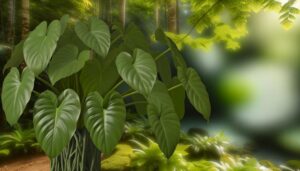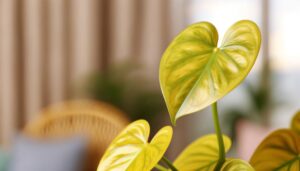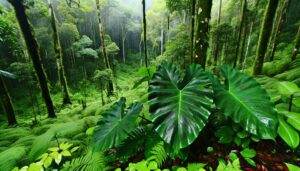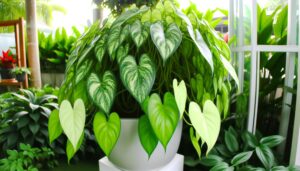What Is a Congo Green Philodendron?
The Congo Green Philodendron, an Araceae family member, thrives in the tropical rainforests of Central and South America. This plant features large, ovate, glossy green leaves and a fleshy stem structure, displaying a compact, clump-forming nature without aerial roots.
It requires moderate to bright indirect light for best growth, with a well-draining, nutrient-rich potting mix. A balanced watering regimen ensures a moist but not waterlogged soil environment.
Effective pest management is essential as it is susceptible to spider mites, mealybugs, and aphids. Understanding these aspects provides a foundation for successful cultivation and maintenance.
For additional knowledge, explore further details.
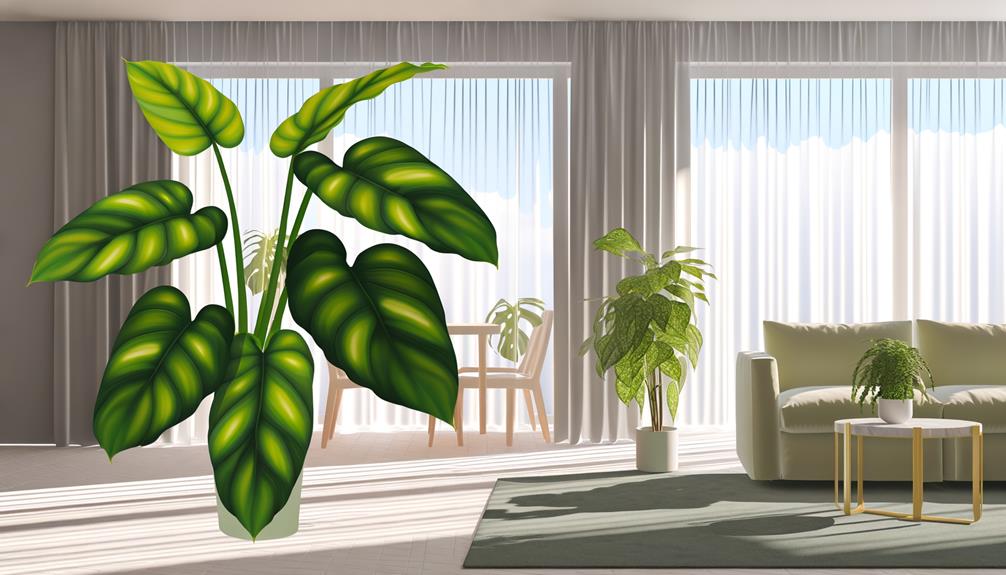
Key Takeaways
- Originates from tropical rainforests of Central and South America.
- Features large, glossy, dark green leaves with a leathery texture.
- Grows upright, reaching up to 3 feet in height with compact form.
- Requires moderate to bright indirect light and balanced watering.
- Functions as an air purifier and has low-maintenance needs.
Origins and History

Originating from the tropical rainforests of Central and South America, the Congo Green Philodendron (Philodendron 'Congo') has a rich history intertwined with botanical exploration and horticultural advancements.
Discovered by early explorers, its unique characteristics quickly captivated botanists. This aroid species, belonging to the Araceae family, was brought to Europe during the 19th century, where it thrived in glasshouse environments.
The Congo Green Philodendron's robust nature and adaptability led to extensive cultivation and hybridization. By the late 20th century, advances in tissue culture techniques facilitated mass propagation, making it a popular ornamental plant.
Today, it is celebrated not only for its aesthetic appeal but also for its contribution to studies in plant physiology and adaptive mechanisms in tropical flora.
Plant Description
The Congo Green Philodendron is characterized by its large, glossy, dark green leaves that exhibit a leathery texture and a robust, upright growth habit. The foliage can reach up to 18 inches in length, presenting a broad, ovate shape with conspicuous venation. The petioles are thick and sturdy, supporting the leaf blades in an erect position.
The plant's overall morphology demonstrates a compact and clump-forming nature, which makes it a popular choice for both ornamental and indoor settings. The stem structure is fleshy and succulent, providing an efficient water storage mechanism. Additionally, the Congo Green Philodendron does not typically produce aerial roots, distinguishing it from other Philodendron species.
This plant's vivid and lush appearance enhances any horticultural collection.
Growth Habits
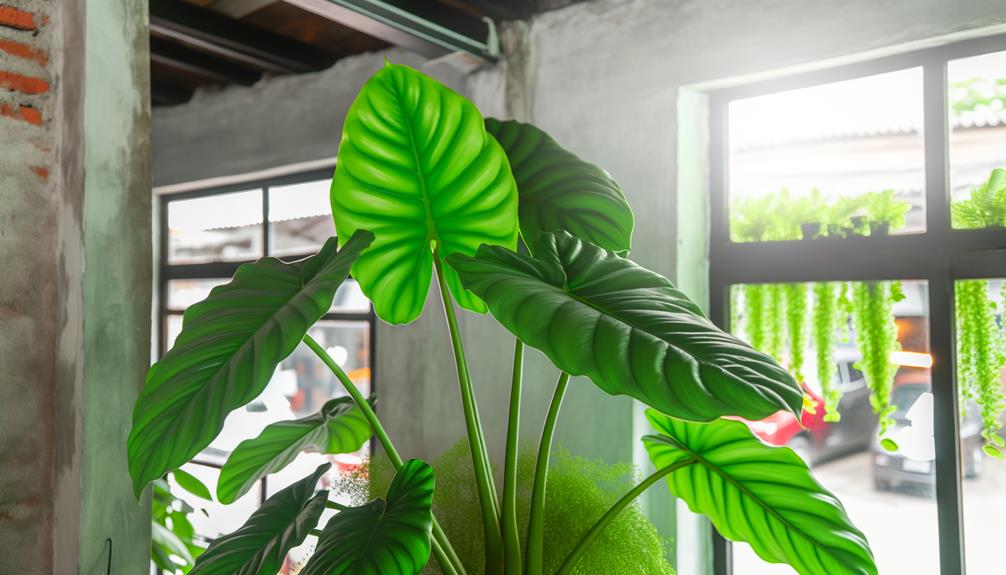
The Congo Green Philodendron exhibits an upright growth pattern, characterized by its vertical stem architecture that supports robust foliage. Leaf size variations are notable, ranging from smaller juvenile leaves to larger, mature leaves, which can greatly influence the overall aesthetic and functional attributes of the plant.
These growth habits are critical for understanding its adaptability in various horticultural settings and optimizing care protocols.
Upright Growth Pattern
Exhibiting a robust and vertical growth habit, the Congo Green Philodendron develops thick, sturdy stems that support its expansive, glossy foliage. This upright growth pattern is a defining characteristic, allowing the plant to reach heights of up to 3 feet, making it an ideal focal point for indoor settings. The plant's architecture is composed of closely spaced internodes, enhancing its structural integrity. Additionally, the Congo Green Philodendron's ability to maintain a compact form reduces the need for frequent pruning. Below is a detailed table summarizing key aspects of its growth pattern:
| Feature | Description | Impact |
|---|---|---|
| Stem Thickness | Robust and sturdy | Supports large leaves |
| Internode Spacing | Closely spaced | Enhances structural integrity |
| Maximum Height | Up to 3 feet | Suitable for indoor focal points |
Leaf Size Variations
In addition to its upright growth pattern, the Congo Green Philodendron exhibits significant leaf size variations, with individual leaves often reaching lengths of up to 18 inches. These broad, ovate leaves are typically dark green and glossy, adding to their striking visual appeal.
The variation in leaf size is influenced by multiple factors including light exposure, soil quality, and overall plant health. Younger plants often display smaller leaves, which gradually increase in size as the plant matures. The substantial leaf surface area enhances photosynthetic efficiency, thereby promoting vigorous growth.
Regular pruning can also impact leaf size, as it encourages denser foliage and potentially larger leaves. Understanding these variations is essential for optimal cultivation and aesthetic maintenance of the Congo Green Philodendron.
Light Requirements
Ideal growth of the Congo Green Philodendron necessitates moderate to bright indirect light, ensuring efficient photosynthesis without exposure to direct sunlight which can cause leaf scorching. This light regimen facilitates optimal chlorophyll function, enhancing the plant's vibrant green foliage.
Inadequate light results in leggy growth and diminutive leaves, indicative of etiolation. Conversely, excess light, particularly direct sun, can lead to photodamage, evidenced by browning or bleached foliar tissue.
For indoor cultivation, situating the plant near east or north-facing windows, or utilizing sheer curtains to diffuse intense light, is recommended. Artificial grow lights, providing a balanced spectrum, can supplement natural light during shorter daylight periods, maintaining consistent growth and health.
Watering Needs
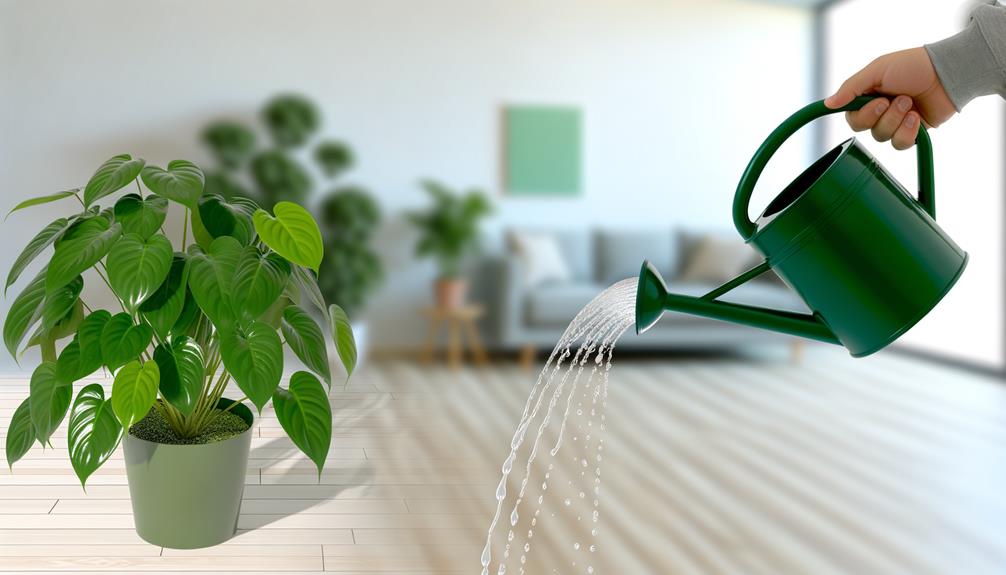
Checking the hydration needs of the Congo Green Philodendron involves a balanced watering schedule, where the soil remains consistently moist but not waterlogged, preventing root rot and promoting strong growth. Monitoring soil moisture levels carefully is essential, making sure the top inch of soil is allowed to dry slightly before re-watering. This practice helps avoid over-saturation, which can result in fungal issues and impaired root function. Using room-temperature water helps maintain the plant's cellular integrity and overall health.
| Factor | Ideal Condition |
|---|---|
| Frequency | Weekly, adjusting as necessary |
| Water Volume | Moderate, avoid pooling water |
| Soil Dryness Check | Top inch should be somewhat dry |
| Water Temperature | Room temperature (20-25°C) |
Regularly evaluating these parameters ensures the Congo Green Philodendron thrives in its indoor setting.
Soil and Potting
Optimizing soil and potting practices for the Congo Green Philodendron involves selecting a well-draining, nutrient-rich substrate to promote robust growth.
Employing containers with adequate drainage holes is critical to prevent waterlogging, which can lead to root rot.
Ensuring proper aeration within the soil mix also facilitates healthy root development and enhances overall plant vigor.
Ideal Soil Requirements
A well-draining, aerated potting mix made up of equal parts peat moss, perlite, and pine bark is crucial for maintaining the health of Congo Green Philodendrons. This specific blend guarantees optimal moisture retention while preventing waterlogging, which can lead to root rot.
Peat moss provides the necessary organic matter and moisture retention, while perlite enhances aeration and drainage. Pine bark contributes to the structural integrity of the mix, promoting root development and preventing soil compaction.
The ideal pH range for Congo Green Philodendrons is slightly acidic to neutral, around 5.5 to 7.0, facilitating nutrient availability. Securing these soil conditions will support vigorous growth and overall plant well-being, aligning with the natural habitat requirements of this tropical species.
Best Potting Practices
In addition to selecting a suitable soil mix, choosing the right container and applying effective potting techniques are fundamental to promoting the health and growth of Congo Green Philodendrons. It is essential to use a container that accommodates the plant's root system while allowing space for expansion. Employing proper potting methods ensures optimal plant health and stability.
- Container Selection: Choose containers with sufficient size and preferably made of breathable materials such as terracotta.
- Soil Composition: Utilize a well-draining, nutrient-rich potting mix, ideally made up of peat, perlite, and pine bark.
- Potting Technique: Gently loosen the root ball before placing the plant in the new container to encourage root development and prevent root-bound conditions.
These practices establish an excellent foundation for growth.
Drainage and Aeration
Proper drainage and aeration are critical components in the cultivation of Congo Green Philodendrons, ensuring that excess water is efficiently removed and that roots receive adequate oxygen.
Utilizing a well-draining potting mix, such as one containing peat, perlite, and orchid bark, is essential. This combination provides a balance between moisture retention and airspace, preventing root rot and compaction.
Containers should have sufficient drainage holes to facilitate water egress. Additionally, incorporating a layer of coarse material like gravel at the bottom of the pot can further enhance drainage efficiency.
Regularly aerating the soil by gently loosening the top layer helps maintain ideal oxygen levels around the root zone, promoting robust growth and overall plant health.
Common Pests
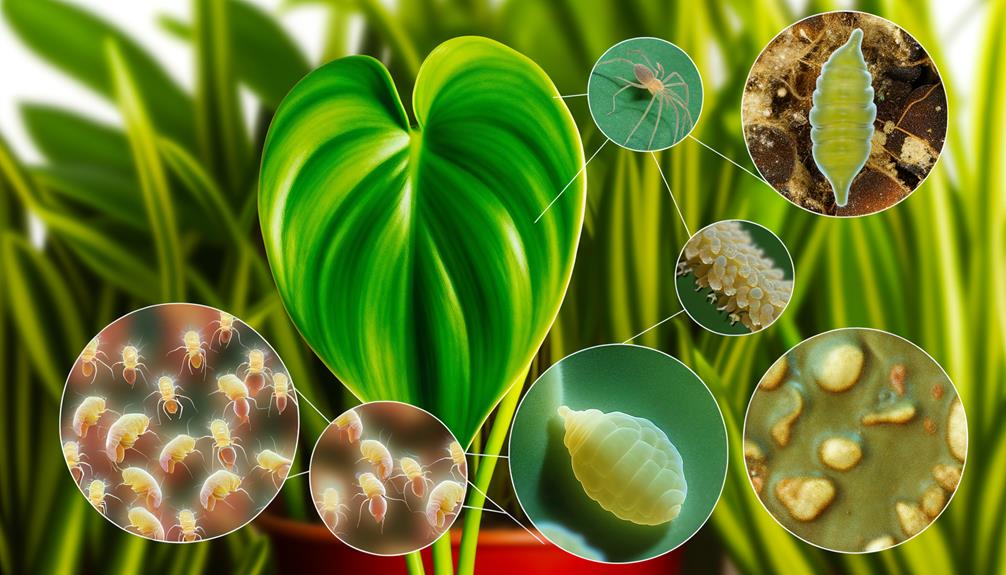
Common pests affecting Congo Green Philodendron include spider mites, mealybugs, and aphids. These pests can cause significant harm, leading to stunted growth and discoloration of leaves.
Spider mites, often found on the undersides of leaves, create fine webbing and cause stippling. Mealybugs appear as white fluffy masses, extracting sap and excreting honeydew, which leads to sooty mold. Aphids, small sap-sucking insects, cluster on new growth, causing leaf curling and deformities.
Key indicators of infestation include:
- Visible webbing or fluffy masses: Indicative of spider mites and mealybugs.
- Distorted or curled new leaves: Signifying aphid activity.
- Sticky residue or black mold: Resulting from honeydew excretion by mealybugs and aphids.
Regular inspection and prompt intervention are vital for effective pest management.
Benefits and Uses
While managing common pests is important for maintaining the health of Congo Green Philodendron, understanding its benefits and uses further underscores its value in horticulture and interior design.
This philodendron species is renowned for its high ornamental value, characterized by its large, glossy leaves and robust growth habit. It functions as an effective air purifier, removing toxins such as formaldehyde and benzene from indoor environments.
The plant's adaptability to low-light conditions makes it ideal for indoor settings, enhancing aesthetic appeal while promoting a healthier atmosphere. Additionally, its low-maintenance requirements and resilience to varying humidity levels make it a favored choice for both novice and experienced gardeners, thereby broadening its application across diverse residential and commercial spaces.
Conclusion
Ultimately, the Congo Green Philodendron, with its robust growth habits and minimal light requirements, serves as an ideal candidate for both novice and experienced horticulturists. Why overlook a plant that offers such ease of care and aesthetic appeal?
Its resistance to common pests and adaptability to various soil conditions further enhance its desirability. Consequently, this philodendron not only enriches indoor environments but also contributes to improved air quality, making it a valuable addition to any botanical collection.

